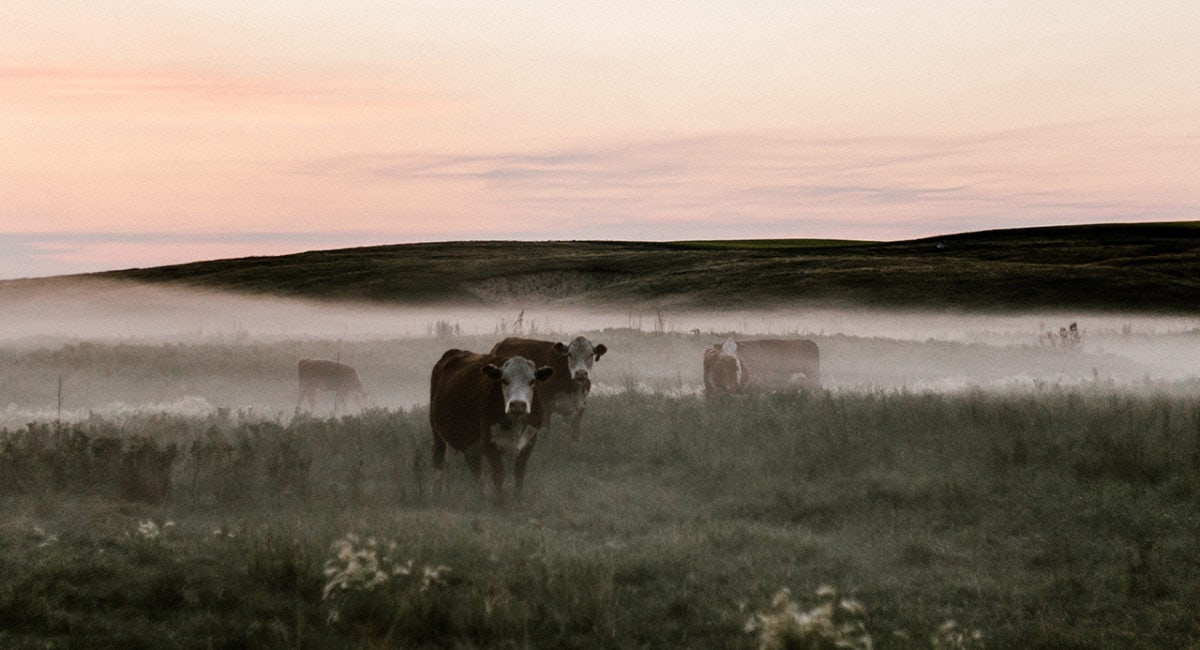Grass-Fed vs Grain-Fed Beef – What’s the Difference?
/ on /
More and more, people who want to eat better meat chose grass-fed beef over conventional beef or grain-fed beef.
Want proof? A recent report on the grass-fed beef market in the United States, using Nielsen data, revealed that sales of fresh, grass-fed beef jumped from $17 million in 2012 to $272 million in 2016. The sales numbers doubled every year as overall beef consumption in America has continued to decrease. Although the percentage of the overall market share is still small, grass-fed beef is slowly converting new fans away from grain-fed feedlot beef.
So what are the actual differences between grass-fed cattle and grain-fed cattle?

Cow-Calf Pasture Life to Yearlings
For the first year or so of the animal’s life, both grass-fed and conventional cattle are raised in the same manner. All calves spend the first six to eight months grazing on pasture, eating grass, and feeding on its mother’s milk. Once weaned, most cattle then spend a period known as the “stocker” or “yearling” phase eating natural grass and forage on pasture for another three to seven months.
Once conventionally-raised cattle attain a weight between 800 to 900 pounds, they are moved to a feedlot to be fattened. Grass-fed and grass-finished cattle remain on pasture the entirety of their lives.
The stocker phase can sometimes be replaced with what is called “backgrounding,” which involves trying to increase the weight of the pastured cattle by mixing grass, and stored forages like hay, and grains. This process is done at backgrounding yards and is meant to get the animals prepared for grain finishing on a feedlot.
The Divergent Path of Grass-Fed and Grain-Fed Cattle
After this pasture raising period—which lasts anywhere from nine to 15 months—conventionally raised cattle are moved to feedlots for confined feeding. At these animal feeding operations—or AFOs—cattle are kept indoors and fed grain to fatten them up for slaughter.
At the AFOs, the EPA specifies that no crops, vegetation, forage growth, or post-harvest residues are “sustained in the normal growing season over any portion of the facility.” Cattle are fed grains, corn, soy, as well as corn that is a byproduct of the ethanol process in order to get them to an ideal weight quicker than pasture-raised cattle.
In the close confines of feedlots, conventionally raised cattle get sick more often than grass-fed cattle, thus, they require antibiotics that pasture-raised animals do not. Additionally, feedlot cattle operations use growth hormones as opposed to cattle that eat grass their entire lives.
On the other hand, 100% or “pure” grass-fed beef comes from cattle that have spent their entire lives on pasture eating a grass and forage diet with “limited, incidental non-grain supplementation.” The terminology “grass-fed and grass-finished” is also used to describe grass-fed beef mainly because some producers misuse of labels, including “grass-fed, grain-finished,” and the rise of “grass feedlots” which feed animals grass and other forage in pellet form in feedlots.
The Major Differences Between Grass-Fed Beef and Grain-Fed Beef
Being raised in these different environments and with different diets has an impact on the beef that we end up consuming. Part of the reason for the rise in grass-fed beef’s popularity among American consumers is that grass-fed beef tends to be more lean.1
Another common misconception is that grass-fed beef doesn’t taste as good as the more marbled beef found in stores. However, an increasing number of consumers are discovering that grass-fed steaks and other grass-fed, grass-finished cuts of beef are not only tender and well-marbled but are melt-in-your-mouth delicious.
Grass-Fed Beef Guide
Table of Contents
About Grass-Fed
- What is Grass-Finished Beef?
- Grass-Fed vs. Grass-Finished
- Grass-Fed vs. Grain-Fed
- 100% Grass-Fed Beef vs. Organic Beef
Benefits of Grass-Fed
- Grass-Fed Beef Benefits
- Grass-Fed Beef in the Most Popular Diets
- Is Grass-Fed Beef Better for the Environment?
Buying Grass-Fed
- Grass-Fed Beef in America
- Why It Is Difficult to Find Butcher Shops
- How to Buy Grass-Fed Beef with No Stores Nearby
Cooking & Eating Grass-Fed
Dennis Keohane is the Editorial Director for ButcherBox.


